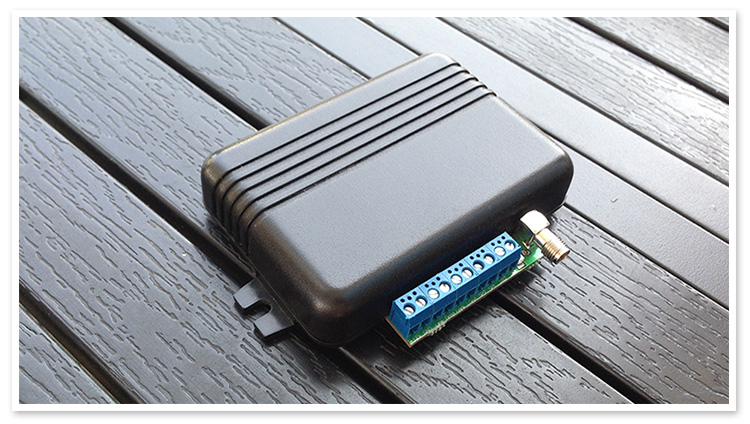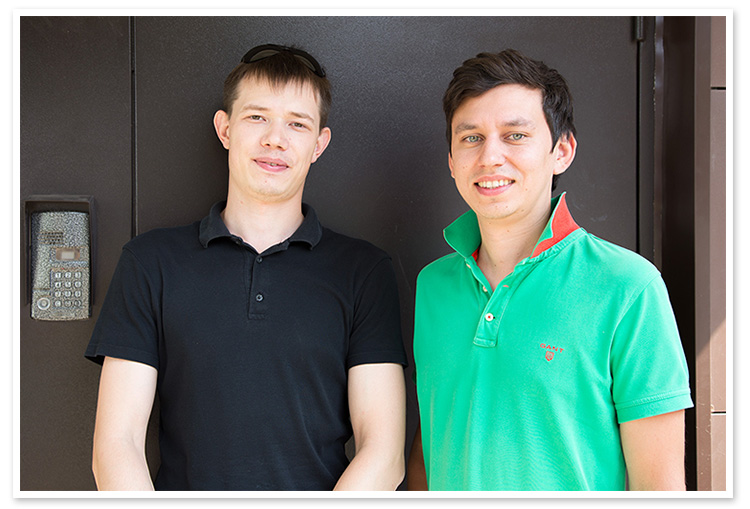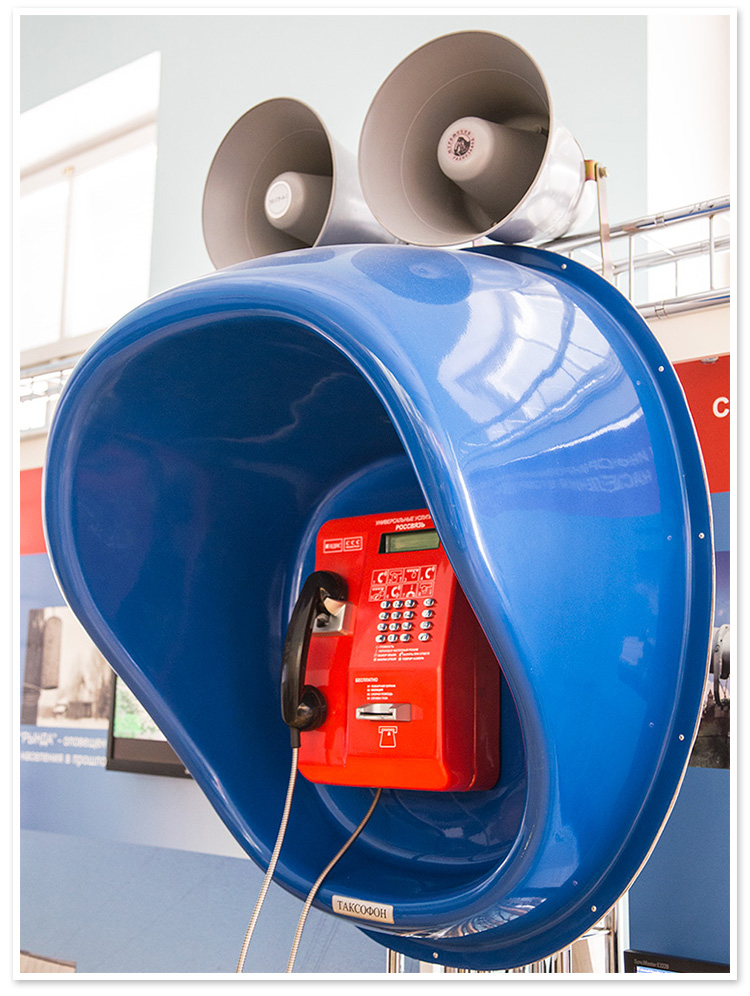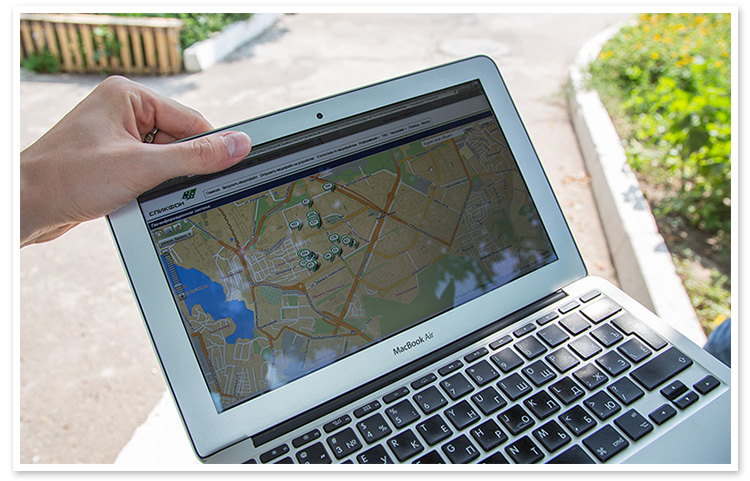Hello, is this an intercom?
In my life, I managed to see many different technical devices - from primitive rattles to sophisticated spaceships. But the development of two guys from Kazan, whom I met almost by accident (they found out on Twitter that I arrived), I was pleasantly surprised - they thought of finalizing something that I had never thought of finalizing before. However, you already understood everything from the title.

Meet: Arthur Abdulin (chief engineer) and Ildar Gaynanov (general director) - the creators of Spikfon, an innovative warning system installed in access doorphones:

I won’t walk around the bush - quite a bit about the principle of the system’s operation is described in their promotional video:
I happened to get acquainted with the “backend” of this system, where I looked at a live example of how everything works, and also found out what the administration panel looks like.
Inside the Speakerphone module (in the first photo) there is a motherboard with special software. Everything is connected to the intercom device and allows the transmission of audio messages of an informational nature through the intercom speaker. The module simply intercepts the control digital and analog signals of the intercom (the moments of opening and closing the door are recognized, as well as the subscriber’s call through the intercom handset) - these events are accepted by the system as the beginning of the message broadcast.
According to the creators, the device can be crossed with almost any model of intercom that are installed in Russia. After installing the module, the intercom continues to work in the previous mode, but gets new features.
At the very least - you can change the melody to some more pleasant one - instead of regular beeping, the residents are given something more melodic. During the test, we turned off the non-standard melody, and the first tenant noticed: “ Uh, where did the good melody go? !! "

Music is music, but instead of it there can be other notifications - any socially significant ones (the selection and preparation of the broadcast information is carried out with the participation of housing and communal services, responsible ministries and departments) lasting up to 8 seconds. “From Monday to Wednesday, hot water will be turned off”, “You have a debt on rent, payment before the end of the month”, “On Friday there will be elections, your polling station - 123” or there is something else - there are a lot of options.
But it is possible, pah-pah-pah, that one day the device will have to work for its main purpose - to inform the population about emergency situations and other troubles. Fire? The intercom begins to ring, the pipes inside the apartments, by the way, can also. A chemical plant exploded? In this case, notifying the house in the "risk zone" will not be a problem. And, believe me, this will work better than an alert on the radio (which no one listens to), on television (which no one is watching), or on the phone (which not everyone has). Not to mention the catch phrase “We should have got around everyone? !!” ...
Moreover - in multi-apartment buildings, one of the doorphones is proposed to be painted in red - from such a doorphone to “112V” it will be possible to make a free emergency call to talk with the operator. Such devices are planned to be additionally equipped with a video camera (external or inside the intercom) - including in order to cut off part of the false calls from home-grown bullies.

Network communication protocol allows you to send messages remotely using GPRS or Ethernet-connection. At the same time, for the system to work in the “Emergency” mode (in case of failure of standard data transfer channels), developers are designing advanced modules with built-in technology for transmitting information via Wi-Fi. It is understood that such an improvement will make it possible to independently organize into a flexible network in the absence of a signal, in which each module will work not only as an end device, but also as a relay-router for other modules (located within a radius of 100 meters). That is, the function "Emergency Call 112" will work all the time, which means that even in the event of a serious disaster and the failure of cellular communications and the Internet, people will still have the opportunity to call the emergency service,
The entire botnet The entire network of doorphones is administered through a web interface, the capabilities of which are already pretty good now.

We select the desired house and entrance on the map, and then set up the intercom: each has about 30 “slots” for audio files, which can be programmed quite flexibly (depending on the action performed by the resident, time of day, etc.). Here's how the device works live:
To date, only a small part of residential buildings in the Vakhitovsky and Privolzhsky districts of Kazan has been equipped with “Speakers”, although the project organizers plan to cover not only all areas of the capital of Tatarstan, but also other million-plus cities of the Russian Federation. And something tells me that they will succeed: the rescue services were very interested in technology, allocated money for development, etc. So far, the system has been sharpened precisely for “rescue needs”, so that the development of “custom chips” has faded into the background. But it would be cool to have your own “personal account” (or even a mobile application), from which you could configure the intercom for yourself. The output is “Keys-documents-iron, traffic jams 4 points”, and at the entrance - “Spartak-CSKA match at 21:00 on the first channel” ... Well, or suggest your scripts in the comments - maybe
Someone will ask - what does this thing have to do with MegaFon, since the article about it appeared in the framework of a special project? It's simple: for the speakerphone to work, you need a good GPRS channel, which Megaphone provides - all the transmitted information is received from the “Speakphone” server via the operator’s network. However, it seems that these devices have a slot for a backup SIM card, which allows the device to stay in touch even in case of any malfunctions at the main operator.
Some more details about the project are on the official website and on Wikipedia .
Guys, come on to us on Habr - you have something to tell! ;)
The remaining posts of our "historical" special project :
" Anatomy of the communications mast
"The history of the development of mail
» About Morse code
» The history of the telegraph
» Thanks to radiophysics
» The history of the appearance of radio
» LTE in Kazan. Universiade
» LTE in St. Petersburg
» LTE in Yekaterinburg
» A brief overview of LTE devices
! Important: This article does not purport to be complete and reliable.

Meet: Arthur Abdulin (chief engineer) and Ildar Gaynanov (general director) - the creators of Spikfon, an innovative warning system installed in access doorphones:

I won’t walk around the bush - quite a bit about the principle of the system’s operation is described in their promotional video:
I happened to get acquainted with the “backend” of this system, where I looked at a live example of how everything works, and also found out what the administration panel looks like.
Inside the Speakerphone module (in the first photo) there is a motherboard with special software. Everything is connected to the intercom device and allows the transmission of audio messages of an informational nature through the intercom speaker. The module simply intercepts the control digital and analog signals of the intercom (the moments of opening and closing the door are recognized, as well as the subscriber’s call through the intercom handset) - these events are accepted by the system as the beginning of the message broadcast.
According to the creators, the device can be crossed with almost any model of intercom that are installed in Russia. After installing the module, the intercom continues to work in the previous mode, but gets new features.
At the very least - you can change the melody to some more pleasant one - instead of regular beeping, the residents are given something more melodic. During the test, we turned off the non-standard melody, and the first tenant noticed: “ Uh, where did the good melody go? !! "

Music is music, but instead of it there can be other notifications - any socially significant ones (the selection and preparation of the broadcast information is carried out with the participation of housing and communal services, responsible ministries and departments) lasting up to 8 seconds. “From Monday to Wednesday, hot water will be turned off”, “You have a debt on rent, payment before the end of the month”, “On Friday there will be elections, your polling station - 123” or there is something else - there are a lot of options.
But it is possible, pah-pah-pah, that one day the device will have to work for its main purpose - to inform the population about emergency situations and other troubles. Fire? The intercom begins to ring, the pipes inside the apartments, by the way, can also. A chemical plant exploded? In this case, notifying the house in the "risk zone" will not be a problem. And, believe me, this will work better than an alert on the radio (which no one listens to), on television (which no one is watching), or on the phone (which not everyone has). Not to mention the catch phrase “We should have got around everyone? !!” ...
Moreover - in multi-apartment buildings, one of the doorphones is proposed to be painted in red - from such a doorphone to “112V” it will be possible to make a free emergency call to talk with the operator. Such devices are planned to be additionally equipped with a video camera (external or inside the intercom) - including in order to cut off part of the false calls from home-grown bullies.

Network communication protocol allows you to send messages remotely using GPRS or Ethernet-connection. At the same time, for the system to work in the “Emergency” mode (in case of failure of standard data transfer channels), developers are designing advanced modules with built-in technology for transmitting information via Wi-Fi. It is understood that such an improvement will make it possible to independently organize into a flexible network in the absence of a signal, in which each module will work not only as an end device, but also as a relay-router for other modules (located within a radius of 100 meters). That is, the function "Emergency Call 112" will work all the time, which means that even in the event of a serious disaster and the failure of cellular communications and the Internet, people will still have the opportunity to call the emergency service,

We select the desired house and entrance on the map, and then set up the intercom: each has about 30 “slots” for audio files, which can be programmed quite flexibly (depending on the action performed by the resident, time of day, etc.). Here's how the device works live:
To date, only a small part of residential buildings in the Vakhitovsky and Privolzhsky districts of Kazan has been equipped with “Speakers”, although the project organizers plan to cover not only all areas of the capital of Tatarstan, but also other million-plus cities of the Russian Federation. And something tells me that they will succeed: the rescue services were very interested in technology, allocated money for development, etc. So far, the system has been sharpened precisely for “rescue needs”, so that the development of “custom chips” has faded into the background. But it would be cool to have your own “personal account” (or even a mobile application), from which you could configure the intercom for yourself. The output is “Keys-documents-iron, traffic jams 4 points”, and at the entrance - “Spartak-CSKA match at 21:00 on the first channel” ... Well, or suggest your scripts in the comments - maybe
Someone will ask - what does this thing have to do with MegaFon, since the article about it appeared in the framework of a special project? It's simple: for the speakerphone to work, you need a good GPRS channel, which Megaphone provides - all the transmitted information is received from the “Speakphone” server via the operator’s network. However, it seems that these devices have a slot for a backup SIM card, which allows the device to stay in touch even in case of any malfunctions at the main operator.
Some more details about the project are on the official website and on Wikipedia .
Guys, come on to us on Habr - you have something to tell! ;)
The remaining posts of our "historical" special project :
" Anatomy of the communications mast
"The history of the development of mail
» About Morse code
» The history of the telegraph
» Thanks to radiophysics
» The history of the appearance of radio
» LTE in Kazan. Universiade
» LTE in St. Petersburg
» LTE in Yekaterinburg
» A brief overview of LTE devices
! Important: This article does not purport to be complete and reliable.
